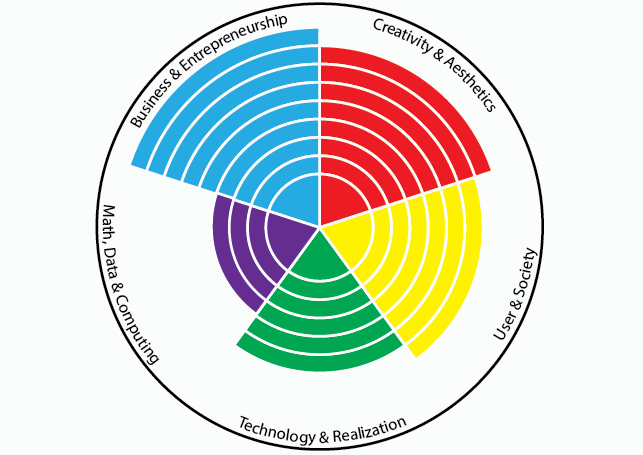This section describes the growth throughout my Bachelor’s, including development and an overview of the expertise areas.
During the first academic year of my Bachelor’s at TU/e, the structure of Design projects was taught means the course of “From Idea To Design” and Project 1. These group projects learned me the approach to design, which allows for freedom of own creativity, in which the group mix & matches insights and perspectives to walk through the design process. Other core electives taught me about the basics of technology, computing and societal values.
Whereas ideation in the first project felt to jump around through the process, Project 2 learned me to approach the design challenge less impulsive. I enjoyed working on the ideation of rich-interaction design elements, where trial & error allowed for adjustments based on feedback loops and insights from user tests. What followed was the research project, which taught the me to design for research. I learned to compute a VR experience, which was used to answer the research question.
I joined University Racing Eindhoven (URE) as a designer, to build on the brand of URE. Designing for branding and overall look of URE got me in contact with a lot of companies and organizations. Besides, I worked on the production of the URE17 where I learned about techniques, materials and production processes, especially in such a large team. Alongside, I followed a few courses which dove deeper into haptics, feedforward and rapid prototyping.
What followed was my 6-month exchange to Singapore, in the department of Industrial Design at NUS. I enrolled in various courses, teaching me about re-branding, CMF Design, Production Materials and sketching. I learned a new perspective on designing, and especially developed new skills about CMF design and re-branding which were very useful for future projects. Moreover, I met a lot other (exchange) students whom I travelled around Asia with, inspiring me about the diversity of cultures and the value of freedom for discovery.
Finally, during my FBP I got to combine my experiences and passion for playful, exploratory methodologies in a solo design project. Looking for opportunities to facilitate connectivity of perspectives, whilst flourishing own values.
Business & Entrepreneurship
The involvement of various perspectives broadens horizons of a design project, providing insights from multiple experts from different fields. As an example: we were able to build the URE17, by gaining knowledge and resources from more than 100 partners. Connecting stakeholders into a project highlights this EA for me, setting up a partnership to learn from each other. This was also proved in the “Buoyant” project; multiple municipalities provided insights in their problem statement and vision, with helped to give more dimension to further design iterations. Alongside, I look into the market potential of a design via the various frameworks, which helps to steer a concept towards promising markets.
Creativity & Aesthetics
Designing offers the freedom to express creativity. During Project 2, I noticed that visualizing concepts helps to communicate and develop the design. I learned various creative mediums to do so, for example quick sketches, digital 3D sketches or rapid prototyping. This conveyed the design’s message. I used the freedom of expression during my time at URE, where I designed branding material such as flyers, posters and magazines using mainly Adobe programs. The CMF design course at NUS taught me a lot about the importance of aesthetics, which influences the look & feel of a design. Especially, I learned to shape designs based on noted aesthetical trends.
User & Society
Design includes the exploration of perspectives to foster own interests and abilities, whilst inspiring others to discover new horizons as well. The project “Buoyant” and “Eindje Meerijden” taught me about the complexity of rather large societal issues, which comes with the diversity in values and needs. Throughout my Bachelor’s, users played a crucial role in the design processes. With my exploratory style, I am able to incorporate users in early stages of the project, providing qualitative and quantitative insights about the user’s values and experience with design concepts. The FBP project “Memory Lane” looks deeper into the values, looking for opportunities to highlight the quality of family values. Moreover, multiple rounds of user groups helped to fine-tune game mechanics for the board game.
Technology & Realization
I developed a profound interest in prototyping during my Bachelor’s, where I noticed the effective way of communicating design via various types of prototypes. Different material and production courses taught me about prototyping techniques, which gained knowledge and skills I later used in projects. For example, the DiVine prototype communicates the rich-interaction design element, and the Buoyant prototype is made from a combination of materials and production techniques such as laser cutting and 3D printing. I enjoy using basic electronics such as Arduino technology, to enrich the user experience of a design. As an example, the FBP Project “Memory Lane” uses Arduino in combination with a speaker and tags to simulate the relive experience with mementos.
Math, Data & Computing
Using available large data allows me to gain insights in large societal problems, alike in the project “Eindje Meerijden”, using large data sets to analyse mobility statuses. Several courses taught me about the usefulness of collecting and processing own data, for example tracking personal activity, and using that data for designing motivational environments. The New Futures squad provides openness in data sharing, which I used in Project 2 and the FBP, where data from other IoT devices was processed to smarten the design. I computed a VR experience during the research project “Virtual Empathy”, where I learned the game-engine Unity. Besides, I enjoy discovering the power (and variety) of programming languages (Python, Arduino, CSS), and to upgrade prototypes with a combination of coding and hardware technology. Project 2 was thus able to communicate means rich-interaction with the user.
